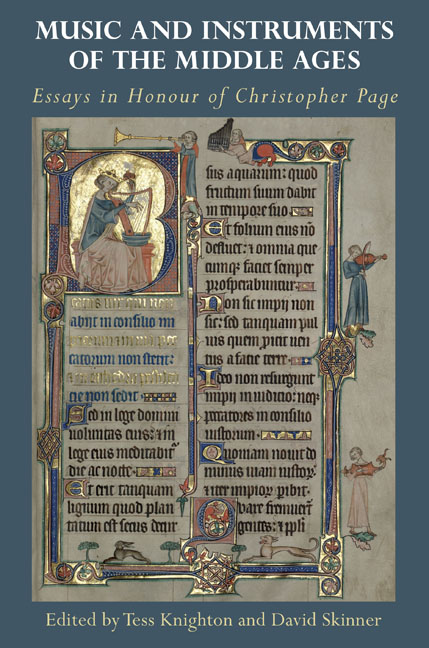Book contents
- Frontmatter
- Contents
- List of Illustrations
- List of Music Examples
- List of Tables
- List of Contributors
- List of Music Manuscript Sigla
- Acknowledgements
- Introduction
- SONGSTERS AND THEIR REPERTORIES
- CLOSE READINGS
- CREATING POLYPHONY
- MUSIC AS CULTURAL PRACTICE
- Works Cited
- Works by Christopher Page
- Index
- Tabula Gratulatoria
- Studies in Medieval and Renaissance Music
2 - Medieval Iberian Song in its Mediterranean Context: From Andalusian Muwashshahat to the Cantigas de Santa Maria
Published online by Cambridge University Press: 24 November 2020
- Frontmatter
- Contents
- List of Illustrations
- List of Music Examples
- List of Tables
- List of Contributors
- List of Music Manuscript Sigla
- Acknowledgements
- Introduction
- SONGSTERS AND THEIR REPERTORIES
- CLOSE READINGS
- CREATING POLYPHONY
- MUSIC AS CULTURAL PRACTICE
- Works Cited
- Works by Christopher Page
- Index
- Tabula Gratulatoria
- Studies in Medieval and Renaissance Music
Summary
In the years 711–14, most of the Iberian Peninsula fell under the rule of the Caliphate of Damascus. In 756 Abd al-Rahman, a descendant of the Umayyad dynasty overthrown by the Abbasids in 750, established himself as Emir (prince) in Cordoba. From 762 onwards Baghdad was the capital of the Abbasid Caliphate; Islamic Iberia (known as al-Andalus) remained a sovereign principality until 929, when it became an independent Caliphate. Eastern influence, facilitated by Arab domination of the Mediterranean, thus became a feature of Andalusian courtly culture.
Eventually, between the ninth and the tenth centuries, Arabic poetry and music and the Western European heritage blended with the Andalus tradition, leading to the creation of zajalesque song, in its double form of zajal (which uses colloquial Arabic) and muwashshah (which uses classical literary language). Its strophic form, involving short, multi-rhymed lines, has been interpreted either as a direct borrowing from popular Romance tradition, or as a result of local adaptation procedures based on Arabic precedent. In spite of its popular character, the zajal made its way into the most cultivated urban circles. Zajal and muwashshah continued to be practised in Iberia much beyond 1031, when the Caliphate of Cordoba fractured into multiple kingdoms; their heyday coincides with the eleventh to twelfth centuries.
Peaceful contacts between the Andalusian south and the Christian Kingdoms in the north of the Peninsula were manifold, and opportunities abounded for cultural exchange even in warfare, through alliances and vassalic links. The consequences of such contacts are, however, often elusive, the more so when the written record is scarce, as normally happens with musical phenomena. Music in the medieval Islamic world was not notated; and although some music from Iberian Christian areas survived in writing, contemporary explanation or commentary is mostly lacking. In this essay, I will consider the areas where southern Mediterranean influence, Eastern or Andalusian, is the more probable, or demonstrable, in Romance-language Iberian song: performance practice, musical form and rhythmic patterning.
PERFORMANCE PRACTICE
According to Jean Lambert, traditional singing in Yemen, at the end of the twentieth century, still followed ancient rules: when singers met, they performed their songs by turns, each turn encompassing at least three songs in succession.
- Type
- Chapter
- Information
- Music and Instruments of the Middle AgesEssays in Honour of Christopher Page, pp. 61 - 76Publisher: Boydell & BrewerPrint publication year: 2020



